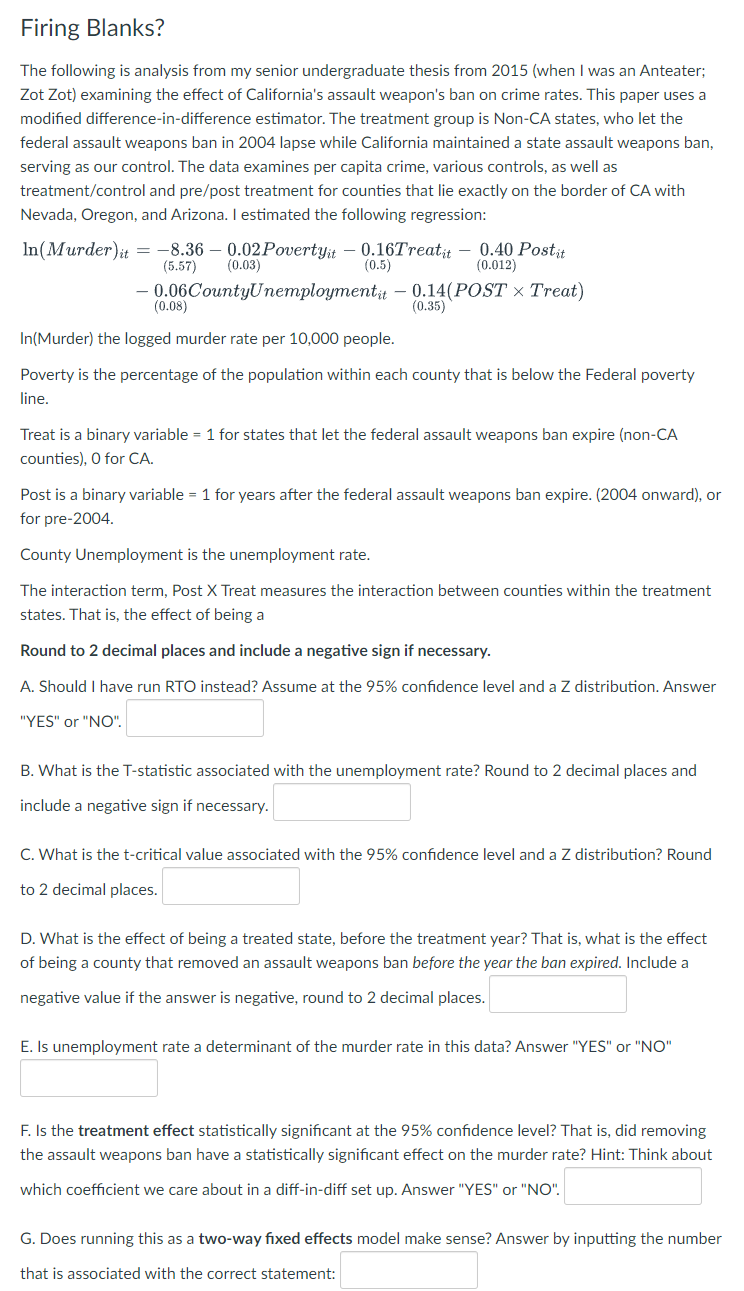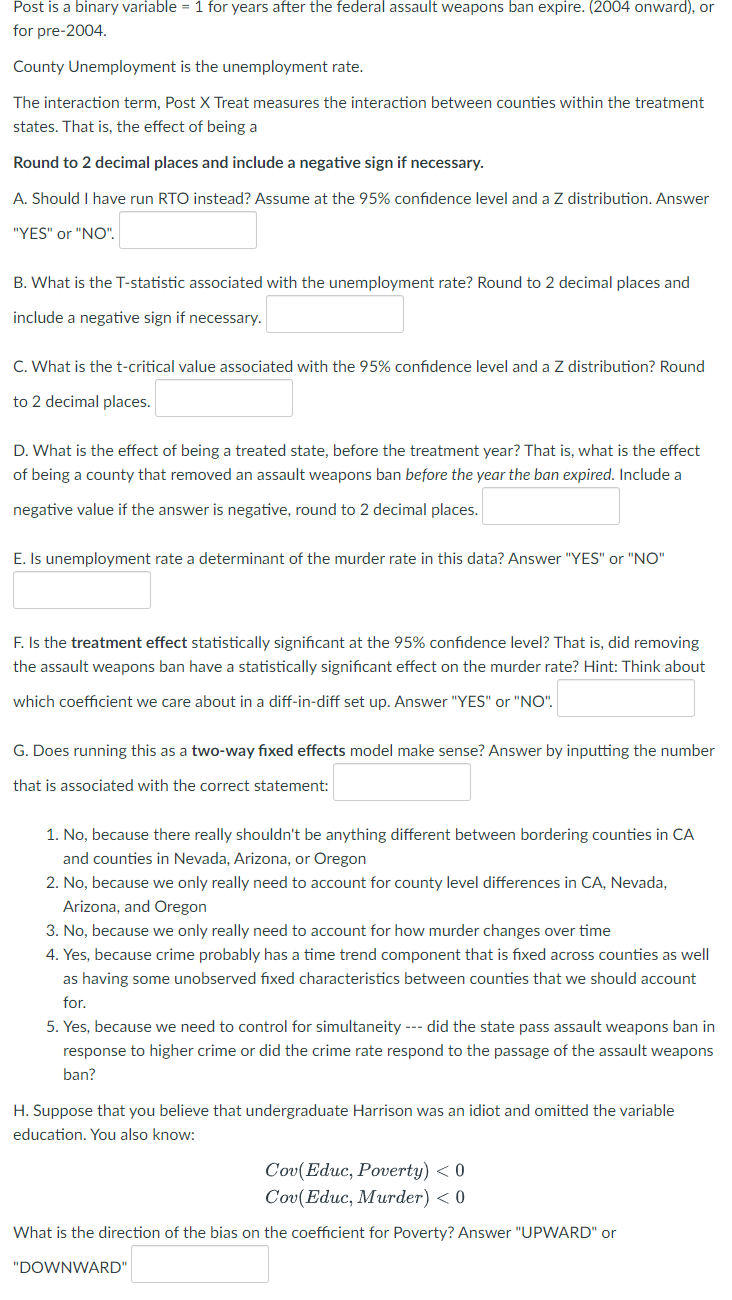Firing Blanks? The following is analysis from my senior undergraduate thesis from 2015 (when I was an Anteater; Zot Zot) examining the effect of California's assault weapon's ban on crime rates. This paper uses a modified difference-in-difference estimator. The treatment group is Non-CA states, who let the federal assault weapons ban in 2004 lapse while California maintained a state assault weapons ban, serving as our control. The data examines per capita crime, various controls, as well as treatment/control and pre/post treatment for counties that lie exactly on the border of CA with Nevada, Oregon, and Arizona. I estimated the following regression: In(Murder)it = -8.36-0.02Povertyit - 0.16Treatit - 0.40 Postit (0.03) (0.5) (0.012) -0.06CountyUnemploymentit - 0.14(POST × Treat) (0.35) (5.57) (0.08) In(Murder) the logged murder rate per 10,000 people. Poverty is the percentage of the population within each county that is below the Federal poverty line. Treat is a binary variable = 1 for states that let the federal assault weapons ban expire (non-CA counties), O for CA. Post is a binary variable = 1 for years after the federal assault weapons ban expire. (2004 onward), or for pre-2004. County Unemployment is the unemployment rate. The interaction term, Post X Treat measures the interaction between counties within the treatment states. That is, the effect of being a Round to 2 decimal places and include a negative sign if necessary. A. Should I have run RTO instead? Assume at the 95% confidence level and a Z distribution. Answer "YES" or "NO". B. What is the T-statistic associated with the unemployment rate? Round to 2 decimal places and include a negative sign if necessary. C. What is the t-critical value associated with the 95% confidence level and a Z distribution? Round to 2 decimal places. D. What is the effect of being a treated state, before the treatment year? That is, what is the effect of being a county that removed an assault weapons ban before the year the ban expired. Include a negative value if the answer is negative, round to 2 decimal places. E. Is unemployment rate a determinant of the murder rate in this data? Answer "YES" or "NO" F. Is the treatment effect statistically significant at the 95% confidence level? That is, did removing the assault weapons ban have a statistically significant effect on the murder rate? Hint: Think about which coefficient we care about in a diff-in-diff set up. Answer "YES" or "NO". G. Does running this as a two-way fixed effects model make sense? Answer by inputting the number that is associated with the correct statement:
Firing Blanks? The following is analysis from my senior undergraduate thesis from 2015 (when I was an Anteater; Zot Zot) examining the effect of California's assault weapon's ban on crime rates. This paper uses a modified difference-in-difference estimator. The treatment group is Non-CA states, who let the federal assault weapons ban in 2004 lapse while California maintained a state assault weapons ban, serving as our control. The data examines per capita crime, various controls, as well as treatment/control and pre/post treatment for counties that lie exactly on the border of CA with Nevada, Oregon, and Arizona. I estimated the following regression: In(Murder)it = -8.36-0.02Povertyit - 0.16Treatit - 0.40 Postit (0.03) (0.5) (0.012) -0.06CountyUnemploymentit - 0.14(POST × Treat) (0.35) (5.57) (0.08) In(Murder) the logged murder rate per 10,000 people. Poverty is the percentage of the population within each county that is below the Federal poverty line. Treat is a binary variable = 1 for states that let the federal assault weapons ban expire (non-CA counties), O for CA. Post is a binary variable = 1 for years after the federal assault weapons ban expire. (2004 onward), or for pre-2004. County Unemployment is the unemployment rate. The interaction term, Post X Treat measures the interaction between counties within the treatment states. That is, the effect of being a Round to 2 decimal places and include a negative sign if necessary. A. Should I have run RTO instead? Assume at the 95% confidence level and a Z distribution. Answer "YES" or "NO". B. What is the T-statistic associated with the unemployment rate? Round to 2 decimal places and include a negative sign if necessary. C. What is the t-critical value associated with the 95% confidence level and a Z distribution? Round to 2 decimal places. D. What is the effect of being a treated state, before the treatment year? That is, what is the effect of being a county that removed an assault weapons ban before the year the ban expired. Include a negative value if the answer is negative, round to 2 decimal places. E. Is unemployment rate a determinant of the murder rate in this data? Answer "YES" or "NO" F. Is the treatment effect statistically significant at the 95% confidence level? That is, did removing the assault weapons ban have a statistically significant effect on the murder rate? Hint: Think about which coefficient we care about in a diff-in-diff set up. Answer "YES" or "NO". G. Does running this as a two-way fixed effects model make sense? Answer by inputting the number that is associated with the correct statement:
Glencoe Algebra 1, Student Edition, 9780079039897, 0079039898, 2018
18th Edition
ISBN:9780079039897
Author:Carter
Publisher:Carter
Chapter4: Equations Of Linear Functions
Section4.5: Correlation And Causation
Problem 11PPS
Related questions
Question

Transcribed Image Text:Firing Blanks?
The following is analysis from my senior undergraduate thesis from 2015 (when I was an Anteater;
Zot Zot) examining the effect of California's assault weapon's ban on crime rates. This paper uses a
modified difference-in-difference estimator. The treatment group is Non-CA states, who let the
federal assault weapons ban in 2004 lapse while California maintained a state assault weapons ban,
serving as our control. The data examines per capita crime, various controls, as well as
treatment/control and pre/post treatment for counties that lie exactly on the border of CA with
Nevada, Oregon, and Arizona. I estimated the following regression:
In(Murder) it = -8.36 0.02Povertyit -0.16Treatit - 0.40 Postit
(5.57) (0.03)
(0.5)
(0.012)
-0.06CountyUnemploymentit 0.14(POST X Treat)
(0.35)
(0.08)
In(Murder) the logged murder rate per 10,000 people.
Poverty is the percentage of the population within each county that is below the Federal poverty
line.
Treat is a binary variable = 1 for states that let the federal assault weapons ban expire (non-CA
counties), O for CA.
Post is a binary variable = 1 for years after the federal assault weapons ban expire. (2004 onward), or
for pre-2004.
County Unemployment is the unemployment rate.
The interaction term, Post X Treat measures the interaction between counties within the treatment
states. That is, the effect of being a
Round to 2 decimal places and include a negative sign if necessary.
A. Should I have run RTO instead? Assume at the 95% confidence level and a Z distribution. Answer
"YES" or "NO".
B. What is the T-statistic associated with the unemployment rate? Round to 2 decimal places and
include a negative sign if necessary.
C. What is the t-critical value associated with the 95% confidence level and a Z distribution? Round
to 2 decimal places.
D. What is the effect of being a treated state, before the treatment year? That is, what is the effect
of being a county that removed an assault weapons ban before the year the ban expired. Include a
negative value if the answer is negative, round to 2 decimal places.
E. Is unemployment rate a determinant of the murder rate in this data? Answer "YES" or "NO"
F. Is the treatment effect statistically significant at the 95% confidence level? That is, did removing
the assault weapons ban have a statistically significant effect on the murder rate? Hint: Think about
which coefficient we care about in a diff-in-diff set up. Answer "YES" or "NO".
G. Does running this as a two-way fixed effects model make sense? Answer by inputting the number
that is associated with the correct statement:

Transcribed Image Text:Post is a binary variable = 1 for years after the federal assault weapons ban expire. (2004 onward), or
for pre-2004.
County Unemployment is the unemployment rate.
The interaction term, Post X Treat measures the interaction between counties within the treatment
states. That is, the effect of being a
Round to 2 decimal places and include a negative sign if necessary.
A. Should I have run RTO instead? Assume at the 95% confidence level and a Z distribution. Answer
"YES" or "NO".
B. What is the T-statistic associated with the unemployment rate? Round to 2 decimal places and
include a negative sign if necessary.
C. What is the t-critical value associated with the 95% confidence level and a Z distribution? Round
to 2 decimal places.
D. What is the effect of being a treated state, before the treatment year? That is, what is the effect
of being a county that removed an assault weapons ban before the year the ban expired. Include a
negative value if the answer is negative, round to 2 decimal places.
E. Is unemployment rate a determinant of the murder rate in this data? Answer "YES" or "NO"
F. Is the treatment effect statistically significant at the 95% confidence level? That is, did removing
the assault weapons ban have a statistically significant effect on the murder rate? Hint: Think about
which coefficient we care about in a diff-in-diff set up. Answer "YES" or "NO".
G. Does running this as a two-way fixed effects model make sense? Answer by inputting the number
that is associated with the correct statement:
1. No, because there really shouldn't be anything different between bordering counties in CA
and counties in Nevada, Arizona, or Oregon
2. No, because we only really need to account for county level differences in CA, Nevada,
Arizona, and Oregon
3. No, because we only really need to account for how murder changes over time
4. Yes, because crime probably has a time trend component that is fixed across counties as well
as having some unobserved fixed characteristics between counties that we should account
for.
5. Yes, because we need to control for simultaneity --- did the state pass assault weapons ban in
response to higher crime or did the crime rate respond to the passage of the assault weapons
ban?
H. Suppose that you believe that undergraduate Harrison was an idiot and omitted the variable
education. You also know:
Cov(Educ, Poverty) < 0
Cov(Educ, Murder) < 0
What is the direction of the bias on the coefficient for Poverty? Answer "UPWARD" or
"DOWNWARD"
Expert Solution
This question has been solved!
Explore an expertly crafted, step-by-step solution for a thorough understanding of key concepts.
This is a popular solution!
Trending now
This is a popular solution!
Step by step
Solved in 3 steps

Recommended textbooks for you

Glencoe Algebra 1, Student Edition, 9780079039897…
Algebra
ISBN:
9780079039897
Author:
Carter
Publisher:
McGraw Hill

Big Ideas Math A Bridge To Success Algebra 1: Stu…
Algebra
ISBN:
9781680331141
Author:
HOUGHTON MIFFLIN HARCOURT
Publisher:
Houghton Mifflin Harcourt

Glencoe Algebra 1, Student Edition, 9780079039897…
Algebra
ISBN:
9780079039897
Author:
Carter
Publisher:
McGraw Hill

Big Ideas Math A Bridge To Success Algebra 1: Stu…
Algebra
ISBN:
9781680331141
Author:
HOUGHTON MIFFLIN HARCOURT
Publisher:
Houghton Mifflin Harcourt